Reflecting on Nursing Clinical Experiences and NSQHS Standards
VerifiedAdded on 2022/09/18
|5
|1530
|24
Report
AI Summary
This report presents a critical reflection on two clinical nursing experiences, connecting them to the National Safety and Quality Health Service (NSQHS) Standards in Australia. The student, a Bachelor of Nursing candidate at the Australian National University Medical School (ANUMS), discusses experiences related to the 'Preventing and Controlling Healthcare-Associated Infection' and 'Medication Safety' standards. The first experience involves a patient with pneumonia, highlighting the importance of infection prevention, patient education, and antimicrobial stewardship. The second experience focuses on a patient undergoing chemotherapy and experiencing an anaphylactic reaction, emphasizing medication safety protocols and the nurse's role in recognizing and managing adverse drug reactions. The report analyzes these experiences, emphasizing the importance of patient assessment, education, and the development of critical thinking skills in nursing practice, supported by relevant literature.
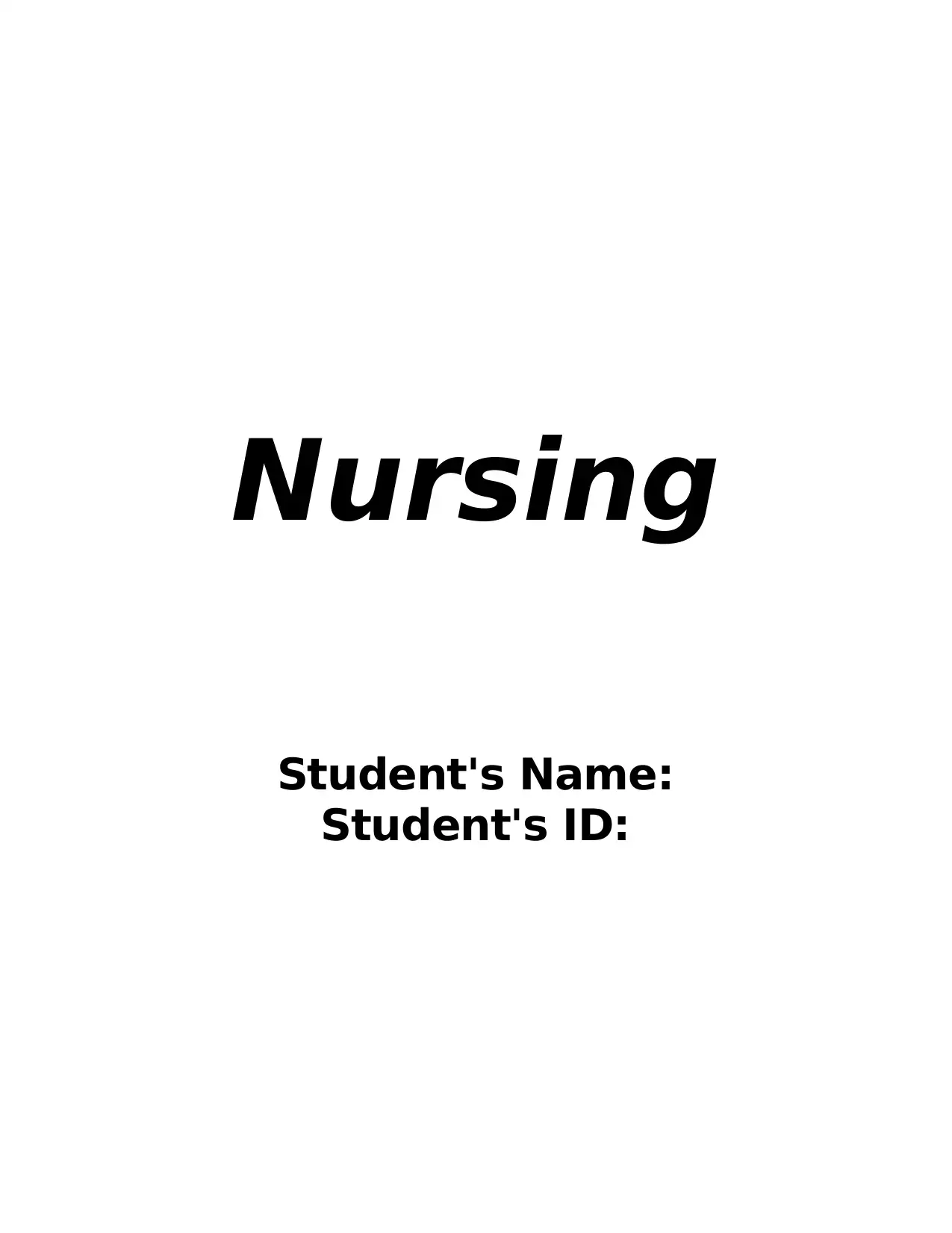
Nursing
Student's Name:
Student's ID:
Student's Name:
Student's ID:
Paraphrase This Document
Need a fresh take? Get an instant paraphrase of this document with our AI Paraphraser
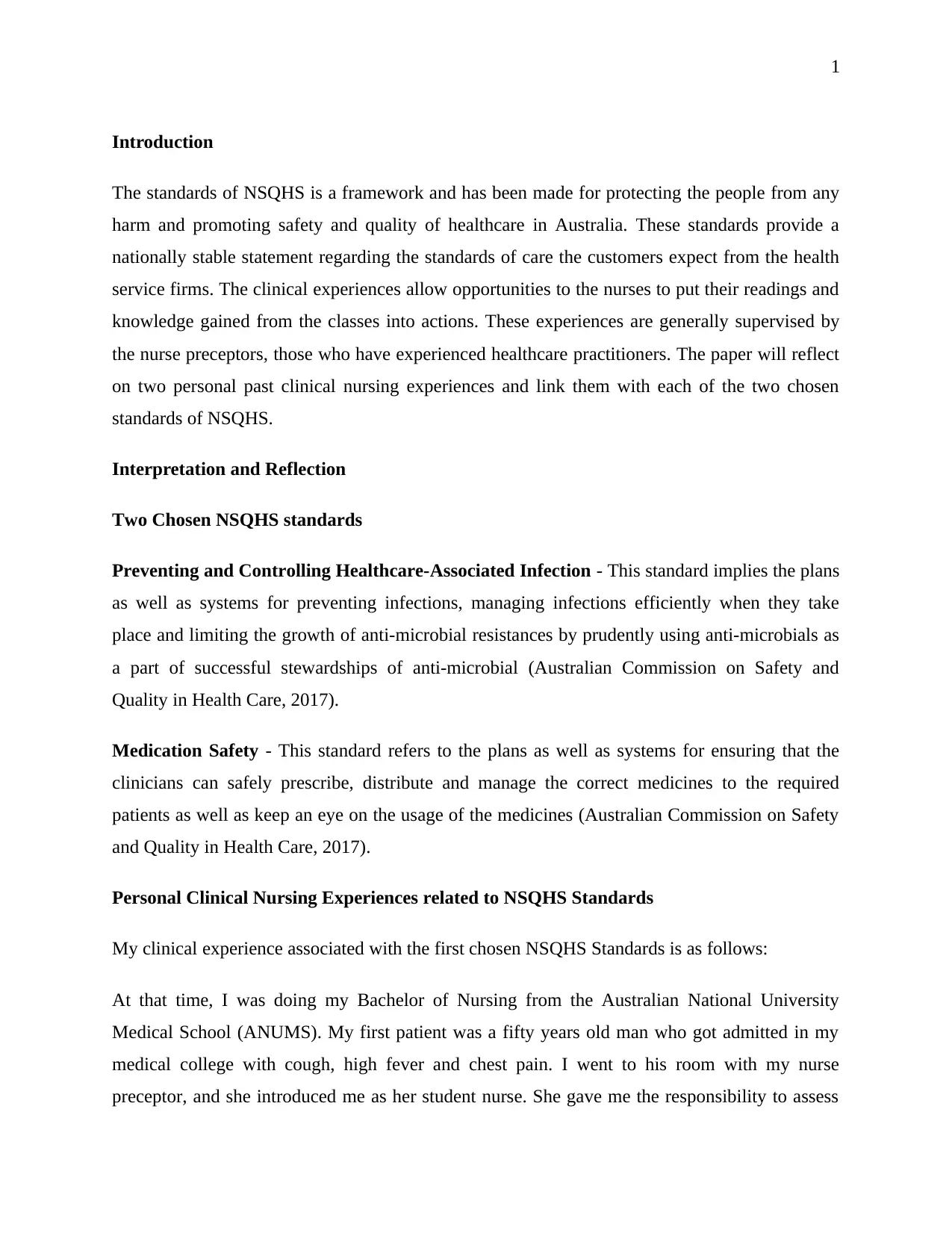
1
Introduction
The standards of NSQHS is a framework and has been made for protecting the people from any
harm and promoting safety and quality of healthcare in Australia. These standards provide a
nationally stable statement regarding the standards of care the customers expect from the health
service firms. The clinical experiences allow opportunities to the nurses to put their readings and
knowledge gained from the classes into actions. These experiences are generally supervised by
the nurse preceptors, those who have experienced healthcare practitioners. The paper will reflect
on two personal past clinical nursing experiences and link them with each of the two chosen
standards of NSQHS.
Interpretation and Reflection
Two Chosen NSQHS standards
Preventing and Controlling Healthcare-Associated Infection - This standard implies the plans
as well as systems for preventing infections, managing infections efficiently when they take
place and limiting the growth of anti-microbial resistances by prudently using anti-microbials as
a part of successful stewardships of anti-microbial (Australian Commission on Safety and
Quality in Health Care, 2017).
Medication Safety - This standard refers to the plans as well as systems for ensuring that the
clinicians can safely prescribe, distribute and manage the correct medicines to the required
patients as well as keep an eye on the usage of the medicines (Australian Commission on Safety
and Quality in Health Care, 2017).
Personal Clinical Nursing Experiences related to NSQHS Standards
My clinical experience associated with the first chosen NSQHS Standards is as follows:
At that time, I was doing my Bachelor of Nursing from the Australian National University
Medical School (ANUMS). My first patient was a fifty years old man who got admitted in my
medical college with cough, high fever and chest pain. I went to his room with my nurse
preceptor, and she introduced me as her student nurse. She gave me the responsibility to assess
Introduction
The standards of NSQHS is a framework and has been made for protecting the people from any
harm and promoting safety and quality of healthcare in Australia. These standards provide a
nationally stable statement regarding the standards of care the customers expect from the health
service firms. The clinical experiences allow opportunities to the nurses to put their readings and
knowledge gained from the classes into actions. These experiences are generally supervised by
the nurse preceptors, those who have experienced healthcare practitioners. The paper will reflect
on two personal past clinical nursing experiences and link them with each of the two chosen
standards of NSQHS.
Interpretation and Reflection
Two Chosen NSQHS standards
Preventing and Controlling Healthcare-Associated Infection - This standard implies the plans
as well as systems for preventing infections, managing infections efficiently when they take
place and limiting the growth of anti-microbial resistances by prudently using anti-microbials as
a part of successful stewardships of anti-microbial (Australian Commission on Safety and
Quality in Health Care, 2017).
Medication Safety - This standard refers to the plans as well as systems for ensuring that the
clinicians can safely prescribe, distribute and manage the correct medicines to the required
patients as well as keep an eye on the usage of the medicines (Australian Commission on Safety
and Quality in Health Care, 2017).
Personal Clinical Nursing Experiences related to NSQHS Standards
My clinical experience associated with the first chosen NSQHS Standards is as follows:
At that time, I was doing my Bachelor of Nursing from the Australian National University
Medical School (ANUMS). My first patient was a fifty years old man who got admitted in my
medical college with cough, high fever and chest pain. I went to his room with my nurse
preceptor, and she introduced me as her student nurse. She gave me the responsibility to assess
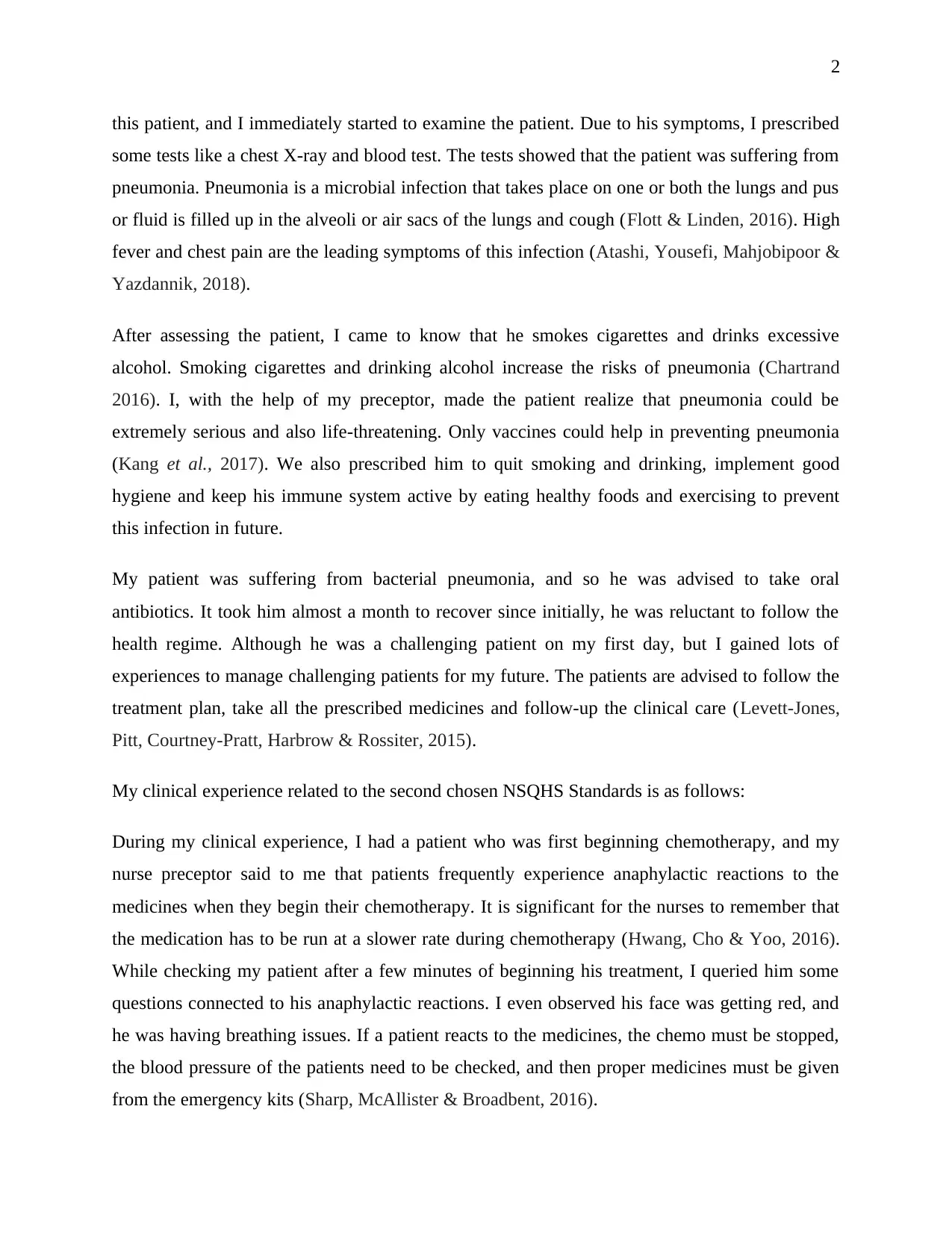
2
this patient, and I immediately started to examine the patient. Due to his symptoms, I prescribed
some tests like a chest X-ray and blood test. The tests showed that the patient was suffering from
pneumonia. Pneumonia is a microbial infection that takes place on one or both the lungs and pus
or fluid is filled up in the alveoli or air sacs of the lungs and cough (Flott & Linden, 2016). High
fever and chest pain are the leading symptoms of this infection (Atashi, Yousefi, Mahjobipoor &
Yazdannik, 2018).
After assessing the patient, I came to know that he smokes cigarettes and drinks excessive
alcohol. Smoking cigarettes and drinking alcohol increase the risks of pneumonia (Chartrand
2016). I, with the help of my preceptor, made the patient realize that pneumonia could be
extremely serious and also life-threatening. Only vaccines could help in preventing pneumonia
(Kang et al., 2017). We also prescribed him to quit smoking and drinking, implement good
hygiene and keep his immune system active by eating healthy foods and exercising to prevent
this infection in future.
My patient was suffering from bacterial pneumonia, and so he was advised to take oral
antibiotics. It took him almost a month to recover since initially, he was reluctant to follow the
health regime. Although he was a challenging patient on my first day, but I gained lots of
experiences to manage challenging patients for my future. The patients are advised to follow the
treatment plan, take all the prescribed medicines and follow-up the clinical care (Levett-Jones,
Pitt, Courtney-Pratt, Harbrow & Rossiter, 2015).
My clinical experience related to the second chosen NSQHS Standards is as follows:
During my clinical experience, I had a patient who was first beginning chemotherapy, and my
nurse preceptor said to me that patients frequently experience anaphylactic reactions to the
medicines when they begin their chemotherapy. It is significant for the nurses to remember that
the medication has to be run at a slower rate during chemotherapy (Hwang, Cho & Yoo, 2016).
While checking my patient after a few minutes of beginning his treatment, I queried him some
questions connected to his anaphylactic reactions. I even observed his face was getting red, and
he was having breathing issues. If a patient reacts to the medicines, the chemo must be stopped,
the blood pressure of the patients need to be checked, and then proper medicines must be given
from the emergency kits (Sharp, McAllister & Broadbent, 2016).
this patient, and I immediately started to examine the patient. Due to his symptoms, I prescribed
some tests like a chest X-ray and blood test. The tests showed that the patient was suffering from
pneumonia. Pneumonia is a microbial infection that takes place on one or both the lungs and pus
or fluid is filled up in the alveoli or air sacs of the lungs and cough (Flott & Linden, 2016). High
fever and chest pain are the leading symptoms of this infection (Atashi, Yousefi, Mahjobipoor &
Yazdannik, 2018).
After assessing the patient, I came to know that he smokes cigarettes and drinks excessive
alcohol. Smoking cigarettes and drinking alcohol increase the risks of pneumonia (Chartrand
2016). I, with the help of my preceptor, made the patient realize that pneumonia could be
extremely serious and also life-threatening. Only vaccines could help in preventing pneumonia
(Kang et al., 2017). We also prescribed him to quit smoking and drinking, implement good
hygiene and keep his immune system active by eating healthy foods and exercising to prevent
this infection in future.
My patient was suffering from bacterial pneumonia, and so he was advised to take oral
antibiotics. It took him almost a month to recover since initially, he was reluctant to follow the
health regime. Although he was a challenging patient on my first day, but I gained lots of
experiences to manage challenging patients for my future. The patients are advised to follow the
treatment plan, take all the prescribed medicines and follow-up the clinical care (Levett-Jones,
Pitt, Courtney-Pratt, Harbrow & Rossiter, 2015).
My clinical experience related to the second chosen NSQHS Standards is as follows:
During my clinical experience, I had a patient who was first beginning chemotherapy, and my
nurse preceptor said to me that patients frequently experience anaphylactic reactions to the
medicines when they begin their chemotherapy. It is significant for the nurses to remember that
the medication has to be run at a slower rate during chemotherapy (Hwang, Cho & Yoo, 2016).
While checking my patient after a few minutes of beginning his treatment, I queried him some
questions connected to his anaphylactic reactions. I even observed his face was getting red, and
he was having breathing issues. If a patient reacts to the medicines, the chemo must be stopped,
the blood pressure of the patients need to be checked, and then proper medicines must be given
from the emergency kits (Sharp, McAllister & Broadbent, 2016).
⊘ This is a preview!⊘
Do you want full access?
Subscribe today to unlock all pages.

Trusted by 1+ million students worldwide
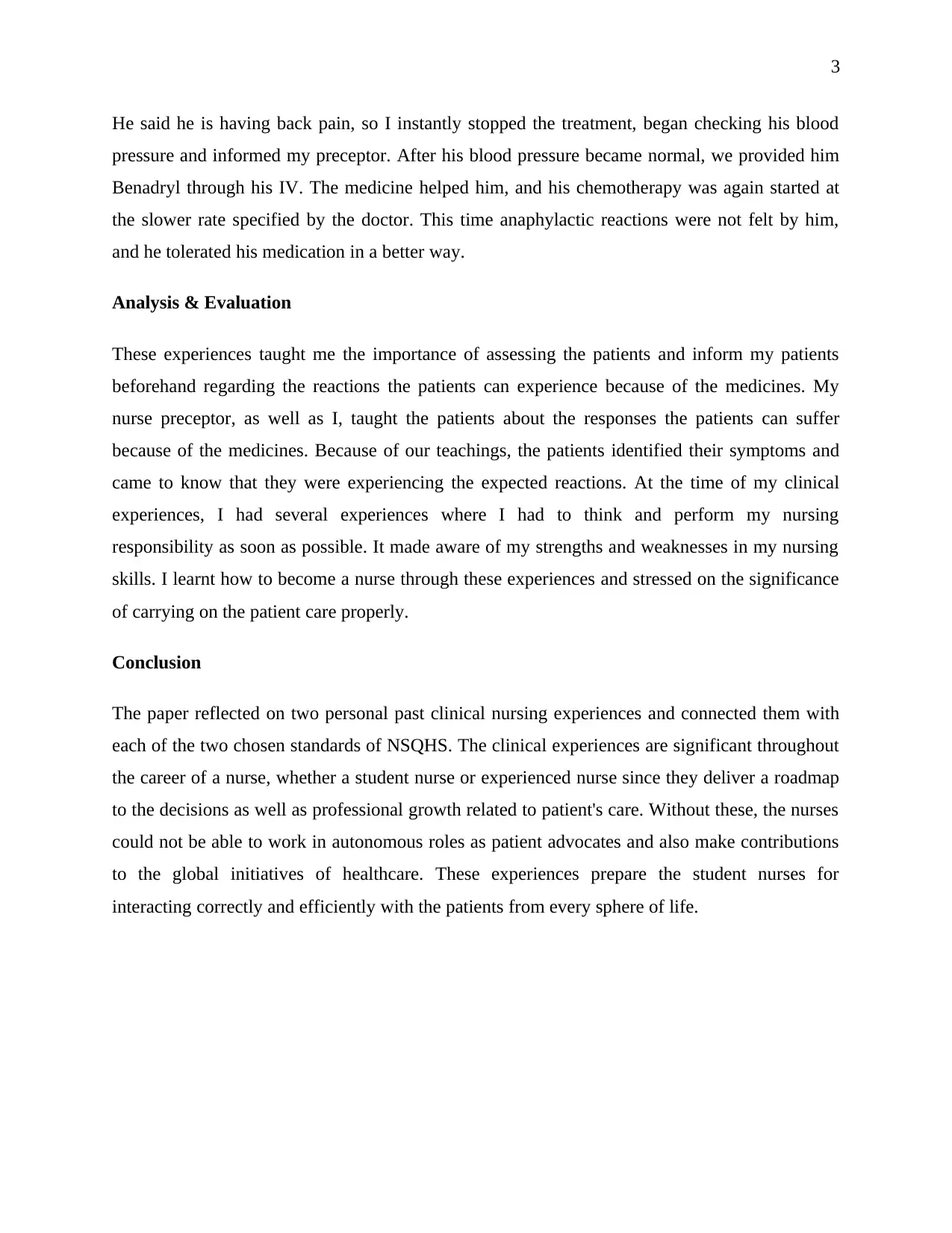
3
He said he is having back pain, so I instantly stopped the treatment, began checking his blood
pressure and informed my preceptor. After his blood pressure became normal, we provided him
Benadryl through his IV. The medicine helped him, and his chemotherapy was again started at
the slower rate specified by the doctor. This time anaphylactic reactions were not felt by him,
and he tolerated his medication in a better way.
Analysis & Evaluation
These experiences taught me the importance of assessing the patients and inform my patients
beforehand regarding the reactions the patients can experience because of the medicines. My
nurse preceptor, as well as I, taught the patients about the responses the patients can suffer
because of the medicines. Because of our teachings, the patients identified their symptoms and
came to know that they were experiencing the expected reactions. At the time of my clinical
experiences, I had several experiences where I had to think and perform my nursing
responsibility as soon as possible. It made aware of my strengths and weaknesses in my nursing
skills. I learnt how to become a nurse through these experiences and stressed on the significance
of carrying on the patient care properly.
Conclusion
The paper reflected on two personal past clinical nursing experiences and connected them with
each of the two chosen standards of NSQHS. The clinical experiences are significant throughout
the career of a nurse, whether a student nurse or experienced nurse since they deliver a roadmap
to the decisions as well as professional growth related to patient's care. Without these, the nurses
could not be able to work in autonomous roles as patient advocates and also make contributions
to the global initiatives of healthcare. These experiences prepare the student nurses for
interacting correctly and efficiently with the patients from every sphere of life.
He said he is having back pain, so I instantly stopped the treatment, began checking his blood
pressure and informed my preceptor. After his blood pressure became normal, we provided him
Benadryl through his IV. The medicine helped him, and his chemotherapy was again started at
the slower rate specified by the doctor. This time anaphylactic reactions were not felt by him,
and he tolerated his medication in a better way.
Analysis & Evaluation
These experiences taught me the importance of assessing the patients and inform my patients
beforehand regarding the reactions the patients can experience because of the medicines. My
nurse preceptor, as well as I, taught the patients about the responses the patients can suffer
because of the medicines. Because of our teachings, the patients identified their symptoms and
came to know that they were experiencing the expected reactions. At the time of my clinical
experiences, I had several experiences where I had to think and perform my nursing
responsibility as soon as possible. It made aware of my strengths and weaknesses in my nursing
skills. I learnt how to become a nurse through these experiences and stressed on the significance
of carrying on the patient care properly.
Conclusion
The paper reflected on two personal past clinical nursing experiences and connected them with
each of the two chosen standards of NSQHS. The clinical experiences are significant throughout
the career of a nurse, whether a student nurse or experienced nurse since they deliver a roadmap
to the decisions as well as professional growth related to patient's care. Without these, the nurses
could not be able to work in autonomous roles as patient advocates and also make contributions
to the global initiatives of healthcare. These experiences prepare the student nurses for
interacting correctly and efficiently with the patients from every sphere of life.
Paraphrase This Document
Need a fresh take? Get an instant paraphrase of this document with our AI Paraphraser
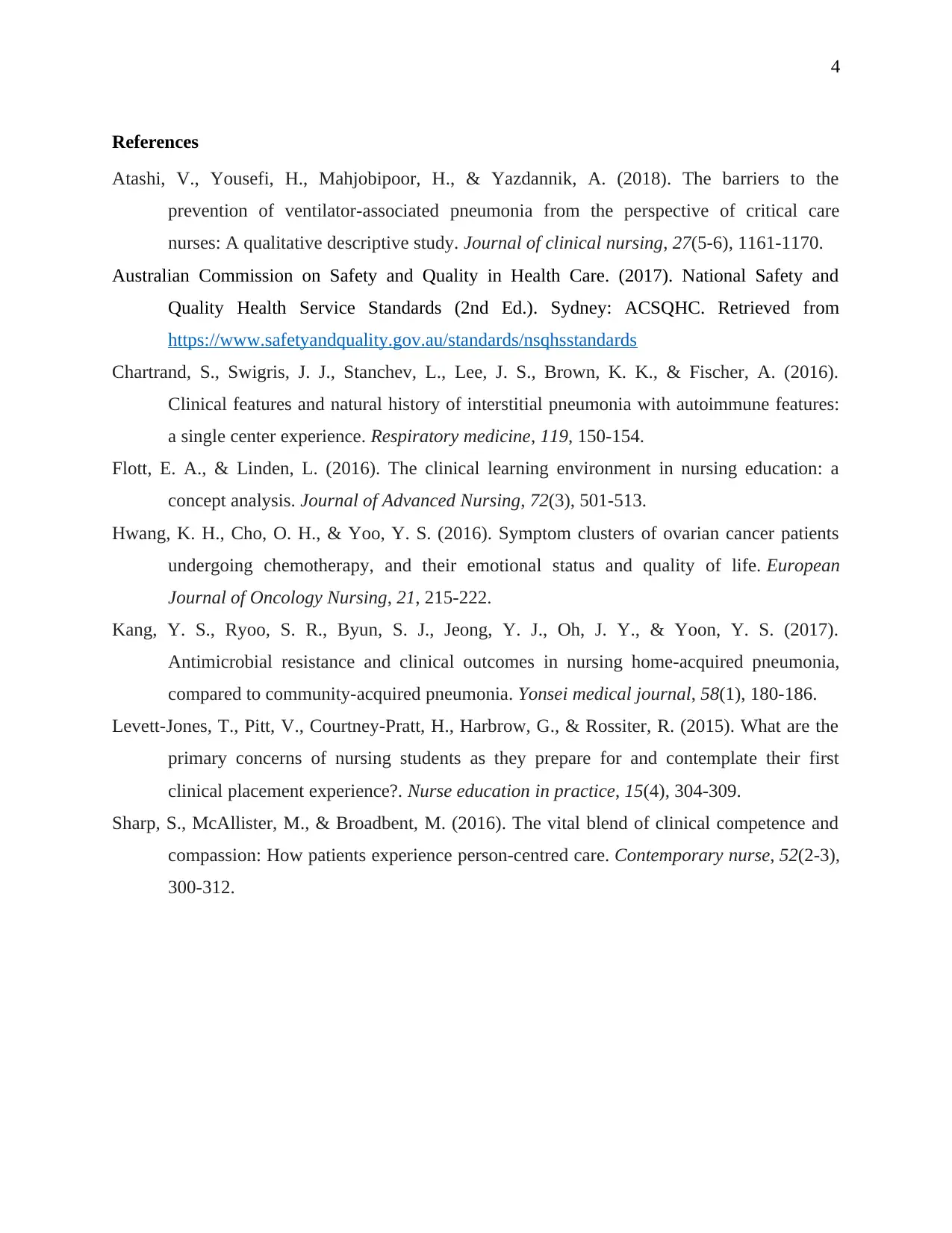
4
References
Atashi, V., Yousefi, H., Mahjobipoor, H., & Yazdannik, A. (2018). The barriers to the
prevention of ventilator‐associated pneumonia from the perspective of critical care
nurses: A qualitative descriptive study. Journal of clinical nursing, 27(5-6), 1161-1170.
Australian Commission on Safety and Quality in Health Care. (2017). National Safety and
Quality Health Service Standards (2nd Ed.). Sydney: ACSQHC. Retrieved from
https://www.safetyandquality.gov.au/standards/nsqhsstandards
Chartrand, S., Swigris, J. J., Stanchev, L., Lee, J. S., Brown, K. K., & Fischer, A. (2016).
Clinical features and natural history of interstitial pneumonia with autoimmune features:
a single center experience. Respiratory medicine, 119, 150-154.
Flott, E. A., & Linden, L. (2016). The clinical learning environment in nursing education: a
concept analysis. Journal of Advanced Nursing, 72(3), 501-513.
Hwang, K. H., Cho, O. H., & Yoo, Y. S. (2016). Symptom clusters of ovarian cancer patients
undergoing chemotherapy, and their emotional status and quality of life. European
Journal of Oncology Nursing, 21, 215-222.
Kang, Y. S., Ryoo, S. R., Byun, S. J., Jeong, Y. J., Oh, J. Y., & Yoon, Y. S. (2017).
Antimicrobial resistance and clinical outcomes in nursing home-acquired pneumonia,
compared to community-acquired pneumonia. Yonsei medical journal, 58(1), 180-186.
Levett-Jones, T., Pitt, V., Courtney-Pratt, H., Harbrow, G., & Rossiter, R. (2015). What are the
primary concerns of nursing students as they prepare for and contemplate their first
clinical placement experience?. Nurse education in practice, 15(4), 304-309.
Sharp, S., McAllister, M., & Broadbent, M. (2016). The vital blend of clinical competence and
compassion: How patients experience person-centred care. Contemporary nurse, 52(2-3),
300-312.
References
Atashi, V., Yousefi, H., Mahjobipoor, H., & Yazdannik, A. (2018). The barriers to the
prevention of ventilator‐associated pneumonia from the perspective of critical care
nurses: A qualitative descriptive study. Journal of clinical nursing, 27(5-6), 1161-1170.
Australian Commission on Safety and Quality in Health Care. (2017). National Safety and
Quality Health Service Standards (2nd Ed.). Sydney: ACSQHC. Retrieved from
https://www.safetyandquality.gov.au/standards/nsqhsstandards
Chartrand, S., Swigris, J. J., Stanchev, L., Lee, J. S., Brown, K. K., & Fischer, A. (2016).
Clinical features and natural history of interstitial pneumonia with autoimmune features:
a single center experience. Respiratory medicine, 119, 150-154.
Flott, E. A., & Linden, L. (2016). The clinical learning environment in nursing education: a
concept analysis. Journal of Advanced Nursing, 72(3), 501-513.
Hwang, K. H., Cho, O. H., & Yoo, Y. S. (2016). Symptom clusters of ovarian cancer patients
undergoing chemotherapy, and their emotional status and quality of life. European
Journal of Oncology Nursing, 21, 215-222.
Kang, Y. S., Ryoo, S. R., Byun, S. J., Jeong, Y. J., Oh, J. Y., & Yoon, Y. S. (2017).
Antimicrobial resistance and clinical outcomes in nursing home-acquired pneumonia,
compared to community-acquired pneumonia. Yonsei medical journal, 58(1), 180-186.
Levett-Jones, T., Pitt, V., Courtney-Pratt, H., Harbrow, G., & Rossiter, R. (2015). What are the
primary concerns of nursing students as they prepare for and contemplate their first
clinical placement experience?. Nurse education in practice, 15(4), 304-309.
Sharp, S., McAllister, M., & Broadbent, M. (2016). The vital blend of clinical competence and
compassion: How patients experience person-centred care. Contemporary nurse, 52(2-3),
300-312.
1 out of 5
Related Documents
Your All-in-One AI-Powered Toolkit for Academic Success.
+13062052269
info@desklib.com
Available 24*7 on WhatsApp / Email
![[object Object]](/_next/static/media/star-bottom.7253800d.svg)
Unlock your academic potential
Copyright © 2020–2025 A2Z Services. All Rights Reserved. Developed and managed by ZUCOL.





